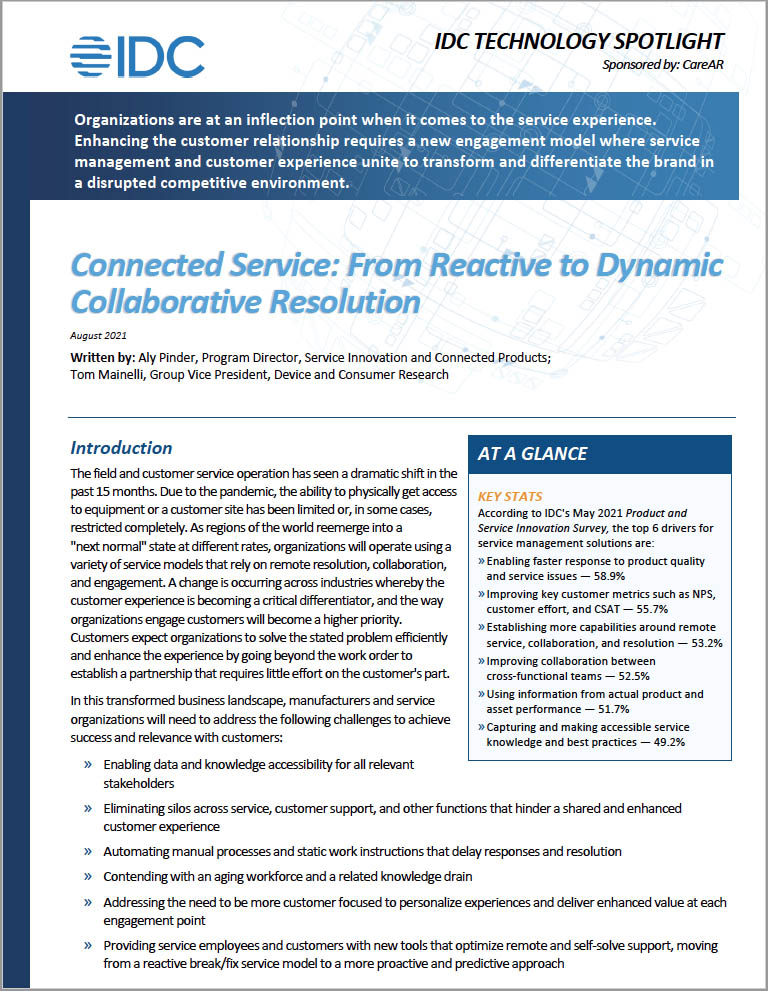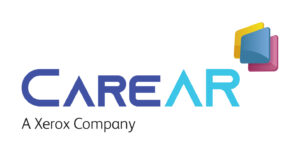The Benefits of Adopting AR Technology
AR technology has evolved dramatically over the past few years. The pandemic drove a big part of that evolution, as companies adapted to an ever-evolving set of circumstances on the ground.
In a 2021 survey of AR adopters, IDC found that the top 3 benefits the technology brought to their businesses were increased worker efficiency, improved real-time collaboration, and improved knowledge transfer between expert and novice workers.
Another driving force behind the current uptick in AR adoption is that an increasing number of companies are finding ways to integrate AR capabilities into their existing workflows and back-end systems. Any organization looking at new technologies to become more dynamic and less reactive must consider the impact on its current processes to leverage existing systems and partners to drive improvements without creating disruption.
Considering CareAR, a Xerox Company
CareAR provides a full suite of end-to-end service experience management (SXM) SaaS-based solutions across service, support, sales, and marketing workflows. The CareAR SXM platform makes expertise accessible instantly for customers, employees, and field workers through live visual AR and artificial intelligence (AI) interactions, instructions, and insights as part of a seamless digital workflow experience. CareAR helps bridge the skills gap and accelerate knowledge transfer through augmenting intelligence while providing greater efficiencies, customer outcomes, and safety as well as reduced carbon emissions.
AI/AR-POWERED SERVICE EXPERIENCES
CareAR delivers critical context through real-time visual AR interactions, instructions, and intelligence as part of a seamless digital workflow. The CareAR SXM platform takes advantage of smartphones, tablets, and other devices such as smart glasses and drones to capture real-time video for a personalized perspective of every support engagement, linking a remote expert with a customer or a field technician. Graphical guidance such as a laser pointer, circles, and annotations is overlaid on video in 3D to create an immersive AR experience. Rear-facing smartphone camera use focuses on the target issue while eliminating visible video lag or latency. Computer vision automatically frames the area being considered. Digital information is overlaid on real-time video with “stickiness” to its intended area despite movement, which is a defining CareAR characteristic. As a result, the real-world visual is blended with digitally created images to focus attention with graphical direction to improve service and support outcomes.
CONTEXTUALIZATION OF CONTENT
CareAR Insight delivers contextual data for greater insights into specific assets, issues, and resolutions. By combining AI with AR, CareAR augments the intelligence of service teams to bridge knowledge gaps and uncover insights into hidden problems. The technology helps the service professional get to the root cause of the issue faster by accessing a full view of the asset’s data, reducing the duration of a service call, and eliminating costly repeat visits
SELF-SOLVE INSTRUCTIONS
CareAR provides a simple but powerful tool to create AR-enabled visual instructions and make information accessible to users. AI-powered computer vision is used to access the collective intelligence of multiple users and then put that information into action. CareAR merges contextual video data with interactive guides to increase a user’s level of knowledge, whether the user is a field service technician looking to fill a gap in knowledge or skills or a customer needing instruction to assemble a device after unboxing.
INTEGRATED WORKFLOWS
CareAR natively integrates with service management platforms such as ServiceNow across customer, field, and IT service management. This end-to-end integration allows field technicians to capture images and recordings during service sessions. That content is automatically saved in the originating work order, case, incident, or knowledge base, eliminating a series of steps to enhance knowledge transfer and ensure proof of work completion or compliance.
SXM USE CASES
AR guidance generated by a remote expert or in the form of self-serve instructions is the most common way AR value is realized. Primary use cases for the company’s solution include:
» Field Service. Supporting technicians paired with an expert located elsewhere using AR is a common use case. Multiple experts or field service technicians may be included in an AR session. Key drivers for this case include:
- Skills. Experts are increasingly in short supply. Field technicians are frequently junior level and/or contractors lacking experience.
- Effectiveness and efficiency. Reduced time to resolve, improved first-time fix rates, reduced truck rolls, and enhanced customer experience are examples of key field service metrics that benefit from the technology.
- Integration. Silos of data lead to disconnected outcomes. Integration across data sources enables intelligence on AR effectiveness, frequency of uses, and CRM connectivity to establish a single view of the data for the field service team.
» Customer Service. Contact center and customer support agents work with customers to resolve issues faster. This is an AR use case that moves the needle on customer experience with emotional impact and enhanced engagement. Key drivers for this case include:
- Internet of Things (IoT). Home devices are becoming more connected and complex. Customers require assistance to overcome language and jargon barriers for effective diagnosis and resolution.
- Customer experience. Customers increasingly prefer to self-serve. But when they fail, they call. When they call, expectations are high and commonly emotionally charged.
- Fewer technician visits. Remote assistance reduces technician visits, which many customers resisted during the pandemic and still prefer to avoid.
» Industry 4.0. AR-enhanced procedural instructions aid employees with assembly and troubleshooting and also help QA staff increase their own efficiency and effectiveness. Key case drivers include:
- Hands-free. Wearables tend to play a more significant role in this use case.
- Step by step. AR guidance and insights are emphasized. Remote expert support also plays a role, especially within complex environments.
- Integration. Instrumentation and procedural adherence are frequently required.
Challenges
Technologies to enable collaboration and real-time remote support are moving beyond the pilot stage for many organizations, especially due to the disruption to the market in 2020. However, any innovative technology, regardless of market shifts, will face challenges in adoption, deployment, and full utilization. Technology firms such as CareAR must address three primary challenges in the market:
» Historically, the adoption of innovative technologies in the customer support and field service market has moved slowly from concept to pilot to scalable production. Establishing a clear adoption path that solves various use cases will help CareAR navigate pilot purgatory.
» Service technology and digital transformation sometimes take a back seat to other digital investments within the manufacturing and service industry. This trend is changing as the impact and importance of the service experience rise in the hierarchy of strategic initiatives, but it is still a challenge.
» Companies such as CareAR must improve the content creation and best practice sharing, validation, relevance, and updating process. Technology to collaborate and capture knowledge is only as good as the content being shared.
Want to know more? Field Service News Subscribers on both our PRO and FREE subscription tiers can access the full white paper now on the button at the top of this article.
This content is sponsored by CareAR

 Data usage note: By accessing this content you consent to the contact details submitted when you registered as a subscriber to fieldservicenews.com to be shared with the listed sponsor of this premium content CareAR who may contact you for legitimate business reasons to discuss the content of this white paper.
Data usage note: By accessing this content you consent to the contact details submitted when you registered as a subscriber to fieldservicenews.com to be shared with the listed sponsor of this premium content CareAR who may contact you for legitimate business reasons to discuss the content of this white paper.


